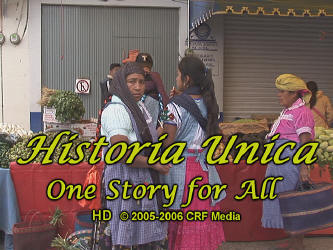|
|
16 Mexico 2005, 2006 13 Chapters (97:13) Script: Mexico 2005-06.pdf 03/25/2023
After producing and publishing Mexico: Bound by Cultural Tradition, we made additional trips in February 2005 and March 2006 to obtain material for a second DVD featuring the indigenous peoples. With our base in Puebla, we visited several cities, towns and villages located in Southern Mexico. Seven chapters from the 2005 trip were produced. Five additional chapters were completed from the 2006 trip.
The indigenous people … those who lived in Mexico before the arrival of the Spanish colonists … make up about 10% of the country’s population. There are 62 officially recognized indigenous tribal groups. Among these people, over 300 dialects and languages are spoken. The clothes they wear, the language they speak, the place they live and their traditional worship practices distinguish one group from another. Histoira Unica, … the one story concept, … makes use of the story-telling skills of the various indigenous people groups. The stories are taught in a manner that even those who are unable to read can repeat them to their family, their friends and others who share a common language and cultural bond. These stories explain who Jesus Christ is but, … still, ... it is difficult to commit their lives to Jesus Christ because of their traditional beliefs. |
|
|
 02 The Queen of Mexico (5:07) The Virgin of Guadalupe is the object of the faith and adoration of most of the people of Mexico as well as other Latin American countries. Her image is everywhere; … in roadside shrines, … small and large statues along the road, … an emblem on a truck, … proudly displayed on a t-shirt, and … as the central monument in many Catholic churches. |
 03 Santo Niño (4:00) Each year on February the second, people from all over the country dress up their special dolls and bring them to the priest. To an outsider, it appears that those entering the church are simply carrying a large well-dressed doll, but … to the participants … it is Santo Niño, the Holy Child. As representations of the Baby Jesus, the dolls are brought up to the front of the church and placed on the altar where the priest bestows a special blessing on each. |
 04 Remaking Chiapas (10:14) This area has been remade many times over the centuries. It was here in southern Mexico and Central America that the Mayan culture once flourished. Today, in the southern State of Chiapas, there are about 750,000 indigenous people. For them … as it was for their ancestors, … the change from power and prestige to poverty is painful. |
 05 The Mixteco People (8:36) The rugged Mixteca Mountains of southern Mexico is the birthplace of a great and noble people. Even before the Mayans … before the Aztecs, there were the Mixteco People. The Mixteco People migrated throughout the Americas but most live in southern Mexico mainly in the State of Oaxaca. Today, the Mixteco population totals about 400,000. |
 06 Mixteca Baja (5:25) The Mixteca Baja People are located in the lowlands and foothills of the Sierra Madre about 150 miles southwest of Mexico City in the State of Oaxaca. There are many small towns and cities scattered throughout these hills, valleys, and plains. Generations have come and gone but little has changed in the lives of the Mixteca Baja. |
 07 Esquela de Misiones (3:15) Established in 2001, the school of missions is held quarterly in different parts of the country. Today classes are being held in the town of Tehuacan. This is one of four theological training schools located among the indigenous people of Mexico in Chiapas, Nayarit and the Sierra Mazateco. |
 08 The Burro (4:48) The people now known as the Nahuatl Guerrero and the burro depend upon each other for their survival. The burro is an essential part of life in the southwestern Mexican State of Guerrero. This is a place where the roads are few, the mountains slopes are steep, and the green valleys are often only in the distance. |
 09 The Mixteco Way - Corn: A Gift From The Gods (5:44) The Mixteco People believe that corn is the basis of all physical life. The divine relationship between the original people of Mexico and that of corn is nowhere more evident than among the Mixtecos who inhabit the mountains and valleys of southwest Mexico in the State of Guerrero. |
 10 Be’ena’a ..."The People" (9:20) “The People”, now known as Zapotecs, have lived in these mountains for more than three thousand years. In the city of Oaxaca, with a population of four million people, over 60% are Zapotecs. For the most part, the Zapotecs living in and around Oaxaca have become a part of the Mexican culture but there are many who never venture far from their homes in the mountains. This is where the Be’ena’a still live. |
|
|
 12 We Are Me’phaa-Not Tlapaneco (9:10) The city of Tlapa is in the State of Guerreo. A’phaa, the place we once called home, was located here. The Aztecs destroyed our life and our people were nearly all killed. The Aztecs, called us “Tlapaneco” which means, “dirty faced ones” in the Aztec language. Today few of the 60,000 residents are Me’phaa. |
|
Statement About Video Use U.S. copyright laws protect all media material produced by CRF Media. Posting the videos on alternate web sites is NOT ALLOWED. Fragmentation of the material is STRICTLY FORBIDDEN. THEY ARE NOT TO BE USED IN ANY WAY FOR COMMERCIAL APPLICATIONS |
|



